
When it comes to managing your finances, you have to understand the question, “what is the opportunity cost of an investment?” This consideration allows you to assess the attractiveness of an investment better.
So what is the opportunity cost of an investment? Opportunity cost is simply the required sacrifice in achieving some gain. For example, a part-time student worker faces the decision of whether to work or study. If the student worker chooses to study, they must forego the benefits of working for this time. So the opportunity cost of studying is the amount of lost wages they could have earned while working for this time.
As another example, imagine you’re making the decision between purchasing two different drinks. The opportunity cost is the lost opportunity at whichever drink you do not pick.
The opportunity cost of an investment works the same way. It represents the value of other investment options available. Investing today is a complex minefield that requires careful decision making. So, there are many additional factors we must consider in determining the opportunity cost of an investment.
What Is The Opportunity Cost Of An Investment?
Opportunity cost is the benefit that an investor or business doesn’t acquire when choosing one investment over another. You usually won’t find the opportunity cost of an investment in the financial reports. However, it’s still crucial to know so you can make better decisions when presented with multiple options.
Ask yourself if your money and time would be better off somewhere else. International finance can be extremely volatile, and you need to keep constantly aware of emerging trends. So, it’s essential to not only examine individual investment decisions based on their own merits but also to consider alternatives to the opportunity in question as well.
This perspective entails a higher degree of risk due to the dynamic nature of markets. It can be difficult to compare investment options, so the risk is an inherent factor in opportunity cost.
Opportunity cost vs. risk
While these terms closely relate, risk and opportunity cost feature key differences. Risk is “the potential drawback from a business or investment decision.” On the other hand, opportunity cost covers the gain and disadvantages you can reap from an investment. So risk involves an element of surprise, while opportunity cost features aspects of sacrifice.
Image by pixabay
Looking at investments
When comparing your potential investments, you have to factor in its profitability. By looking at the option that will give you the highest return, you should be successful. However, this isn’t all you should keep in mind.
As a business-minded person with a set amount of money, you must choose between investing your funds in a new venture or buying new equipment. Whichever option you choose, the potential profit you miss by not investing in the other choice is the opportunity cost. And this idea is essential when considering an investment.
Image by pixabay
Examples of opportunity cost
What is the opportunity cost of investment? To make this principle easy to comprehend, you have to apply it in real life. Think of a building owner who decides to invest $10,000 by building a convenience store on the second floor of his building. The opportunity cost of this business decision is that he will no longer get income by renting this space out for as office space.
This concept isn’t only applicable to investments. It also applies to business decisions. Let’s say a farmer chooses to plant mango seedlings on a particular patch of land. As a result, the space and money spent on seedlings can no longer serve to grow other crops such as tomatoes or coconuts. The opportunity cost of growing mangoes on a finite piece of land is that the other crops cannot grow simultaneously.
Another example is someone with $10,000 in savings. Suppose this person can either invest their money in a car coating company or use the money to get their graduate degree. If this person uses their money to invest in the car coating company, their opportunity cost is the lifetime earnings and benefits of completing their advanced degree.
Positive Or Negative Opportunity Cost
Opportunity cost can either be positive or negative. For example, a farmer may make more money by selling mangoes compared to planting cucumbers or tomatoes. The opposite can also happen. There are a lot of factors in the market during the planting season that could make mangoes more or less valuable.
While many people only think of money when considering what is the opportunity cost of an investment, you need to consider additional resources. These resources include labor, time, and the required workload of managing the investment.
For instance, the farmer can choose to plant one crop over the other, but he might spend more on labor during planting and harvesting times, depending on the crop. The opportunity cost of the labor-intensive crop isn’t just financial; it also includes the time and money he spends for people working in the field.
Applications of opportunity cost
In assessing the attractiveness of an investment, you must consider all its possible outcomes. Any responsible investor would consider these negative and positive effects during the decision-making process.
Although no one truly knows what the future holds, you have to realize the opportunity cost of an investment so you can weigh the expected results of the available options.
While the examples listed above make sense to building owners and farmers, it can also have equal importance in regards to investments. If you know what is the opportunity cost of an investment, you can apply it to all areas of investments that involve the use of resources. Whether it’s investing in your inventory stock or thinking about your storage space, learning how to assess your options is important.
Why Opportunity Cost Is Important

Image by pixabay
Understanding the basics of “what is the opportunity cost of an investment” is similar to mastering trade-offs, one of the foundations of economics. This knowledge is not only valuable in business and investing, but also in your daily life.
Once you make a particular choice, you say goodbye to other options. So you need to factor in opportunity cost when making any decision.
How To Calculate Opportunity Cost
There is no single mathematical formula used to calculate what the opportunity cost of an investment is. However, you can still approach this problem using mathematics.
Measuring opportunity cost leads to better decision making. To know this, you have to note what you are sacrificing. Will it be a change in your lifestyle or finances?
Factors to consider in calculating the opportunity cost
To know the opportunity costs, you have to consider the three factors of time, money, and sweat equity.
Money

Image by pixabay
In terms of money, the opportunity cost is rather straightforward. Ask yourself what else you would do with the funds you are about to spend on your decision. The alternative use of your money is the opportunity cost of an investment.
A farmer who spends $5,000 on tractors owns the equipment but will lose the use of their capital. That same money could hire a part-time employee during the busy season or even open a new store. So these options represent the opportunity cost of buying the tractors.
Sweat equity

Image by pixabay
If you invest your time in your own business, you have to factor in the effort required to make a business work. That effort can either lead to a successful business venture or be a missed opportunity by dedicating your time working for another company.
Time

Image by pixabay
Money and effort are not the only commodities you have to keep in mind. You also have to factor in time. In determining the opportunity cost, time is sometimes more valuable than money. When making an investment decision, think of the time required or saved by a particular investment opportunity.
The formula for calculating the opportunity cost

Image by pixabay
Dollars cannot account for all aspects of value. And you can find out the opportunity cost in terms of satisfaction or even time. To determine your opportunity cost, use the ratio of what you are sacrificing and gaining.
This method will allow you to evaluate the ratio between two or more choices to estimate opportunity costs.
Examples of opportunity cost of an investment
You can figure out the opportunity cost by factoring in what you sacrifice over what you gain. In the investment example mentioned above, a person is sacrificing either the benefits of possessing a graduate degree or the profit they can make by investing in a car coating company.
Here’s another example. Vin has $$ worth of stocks in a food company, which he can sell for around $30,000. He initially wanted to wait six months before selling his shares since the stock price is likely to increase. However, imagine he decides to sell his stock now. To calculate its opportunity cost, you need to estimate the stock’s value in six months.
Suppose the stock value increased to $$$ in six months. Now, it is possible to determine the opportunity. In this case, the opportunity cost is the difference between the current and future value of the stock. So, the opportunity cost is $5,000 in this example.
Investing Is Now Easier
Investors always face options on where to put their money to receive the most significant return. In today’s business landscape, calculating the opportunity cost of an investment is a required step in assessing a business or investment decision.
Opportunity costs exist everywhere and are both big and small. This concept doesn’t just apply when answering the question, “What is the opportunity cost of an investment?” — it applies to many major decisions throughout your life.
Think about what would have happened if Steve Jobs did not start Apple and decided to stay at IBM. Then, important technological investments may not have come to pass or come in a timely fashion. So be sure to consider opportunity cost as you face your next decision.
Do you have your own experience that relates to calculating what is the opportunity cost of an investment? We’d love to read about it in the comments below!


